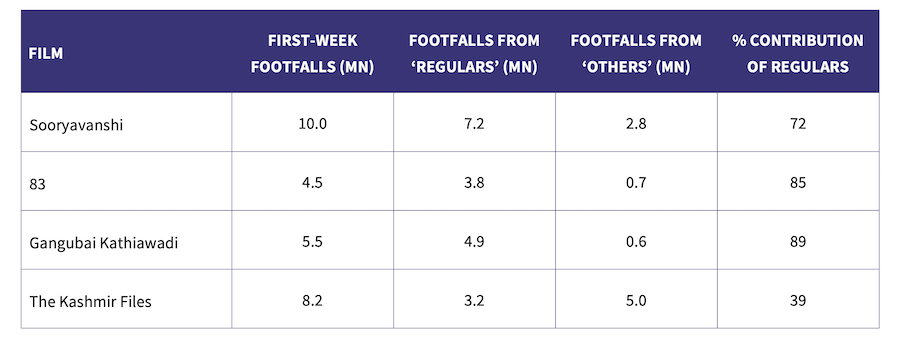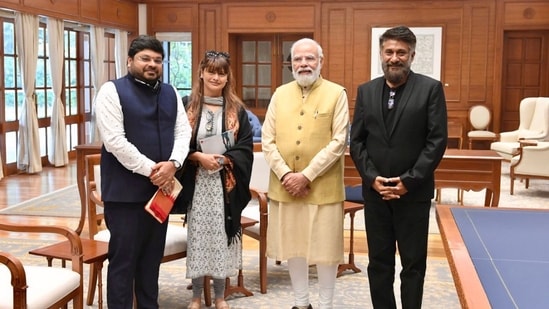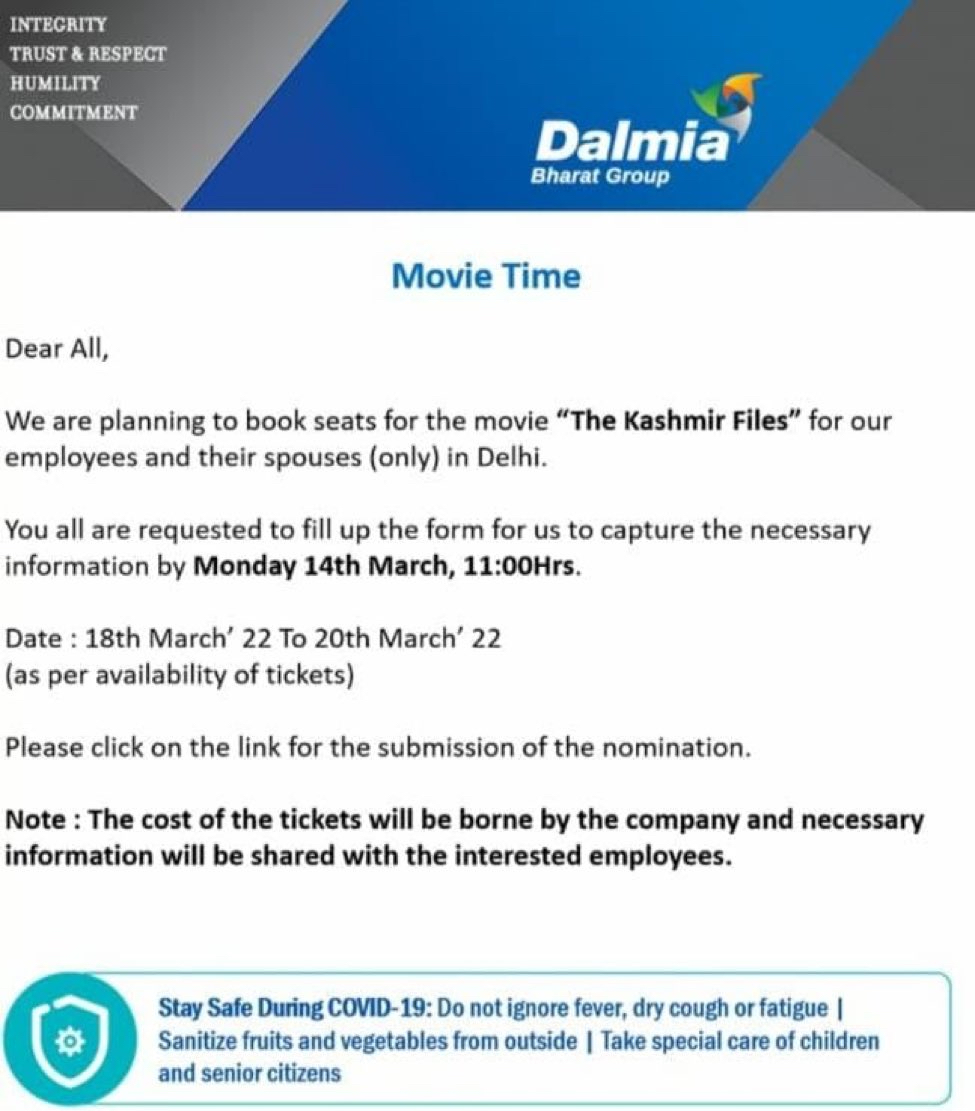


The Kashmir Files has emerged as a huge blockbuster at the box office. There have been instances of small films surpassing expectations in the past too (1975’s Jai Santoshi Maa comes to mind, as does 2019’s Uri: The Surgical Strike). But ‘surpassing expectations’ is an understatement to describe the box office of The Kashmir Files (TKF). The film has managed to break every conventional norm of box office trending, starting with about ₹3 Cr (domestic nett) on its first day (March 11), and peaking at ₹26 Cr on its second Sunday (March 20). On its way, it took down Bachchhan Paandey, a film that would normally be expected to touch the ₹100 Cr mark, but will end up about ₹50 Cr short.
A day before the release, TKF was tracking at a notch less than ₹1 Cr on Ormax Cinematix (OCX). OCX is our tool that tracks a film’s campaign from its trailer till its release, reporting FBO (First-Day Box Office forecast) as a primary output. There have been instances in the past where the actual performance of small films has exceeded their FBO because of good reviews and audience advocacy on the day of the release, leading to additional footfalls after 6 PM on Friday. But here, no conventional box office logic explains how well the film (which the meteorologically-obsessed film trade has described as a tornado, a hurricane and a tsunami) has performed.
Is the success of TKF a watershed moment in Hindi cinema? Has the time come for star vehicles to take a backseat, and ‘content-driven cinema’ to lead the way? The Indian entertainment industry is not immune to drawing hasty conclusions (till mid last year, the theatrical sector was being written off because streaming was supposed to be the future of cinema). The narrative that TKF will fundamentally alter the kind of films that are made, because it represents the changing audience taste, gained ground over the film’s first weekend.
I am generally skeptical about hypothesis that question habits and taste built over several years, if not decades. What surprised me in particular was that the film had unusually-high advance bookings even on its first day. Even the biggest films don't get much traction on advance bookings in the major multiplexes in the metros, simply because tickets are easily available most of the time.
Using some hard numbers, I decided to investigate. Having reached a conclusion of sorts, I tweeted the following on the fourth evening of the film.
The huge success of The Kashmir Files makes for a great case study about Indian politics in today's times. What it doesn't make for is a case study about Indian movie business/ box office.— Shailesh Kapoor (@shaileshkapoor) March 14, 2022
This tweet led to several questions, tempting me to write this report. Since the tweet above, more data has come in. And the numbers tell a fascinating story. Read on.
The Regulars
At the heart of this analysis is an audience segment called “Regulars”, which we define as people who watched three or movie Hindi films in a theatre in the last 12 months. At just one film in four months, it’s not a very stringent definition. This audience segment drives the Hindi box office, including that of the biggest films. 79% of Bollywood’s 341 Mn footfalls in 2019 (the last pandemic-free calendar year) came from the Regulars. If you look at just the first-day footfalls, the contribution of the Regulars goes up to 92%.
There are only about 34 Mn Regulars in India. 74 Mn Indians watched at least one Hindi film in a theatre in 2019 (details). But less than 50% of them went on to watch at least three. The fate of an entire ‘mass’ industry, thus, is in the hands of these 34 Mn (3.4 Cr) Indians. This number has been tracked as a part of The Ormax Bollywood Audience Report (TOBAR) over the years, and has been in the 30-40 Mn range through the last decade. There are no signs of it changing post the pandemic either.
Understandably then, OCX tracks only the Regulars. The ₹1 Cr opening that TKF was expected to get was based on data collected from a sample from the Regulars. Hence, when the eventual number turned out to be three times, I wondered if the ‘Others’ (the Irregulars and non-theatre goers) have contributed disproportionately to the film’s box office.
The Findings
This analysis is based on the first-week (domestic) footfalls of four recent films: Sooryavanshi, 83, Gangubai Kathiawadi and The Kashmir Files. The table below compares the proportion of footfalls of the four films from the Regulars, vis-à-vis the ‘Others’.

83 and Gangubai Kathiawadi got more than 85% of their first-week footfalls from the Regulars, a typical scenario for most films. Sooryavanshi was a Diwali release, and festive releases manage to get the Irregulars to the theatres, which is why the contribution of the Regulars is lower at 72%.
TKF saw a staggering 61% contribution from the ‘Others’, many of which may not even be the Irregulars. These are people who rarely, if ever, go to a movie theatre. 5 Mn of them made a trip to watch TKF in its first week. In the Diwali week, Sooryavanshi managed only 2.8 Mn from this ‘secondary’ audience group.
A search in our database to find a film that got more than 50% of its first week audience from outside the Regulars group drew a blank. Among all the films with lifetime box office of ₹25 Cr or more, Tanhaji (2019) is on the top of list, with 38% contribution from the ‘Others’. Some of these are Marathi (but not Hindi) film audience who watched the film because of its evident regional significance.
An interesting name, however, comes up if one takes a cursory look at the less-than-₹25Cr list. PM Narendra Modi, the 2019 biopic got 43% of its 2 Million footfalls from outside the Regulars group. At 61%, TKF has broken that record by a distance.
The Others
The evident question, then, is: Who are these 5 Mn ‘Others’ who thronged the theatres to watch TKF? The answer, like the film, is political in nature. The film has been endorsed by the Central Government and several BJP-led State Governments since its release. This includes photo-ops with the Prime Minister, the Home Minister and arguably the most powerful Chief Minister in the country today.

Thanks a lot @AmitShahOffice ji for your encouragement. Your consistent efforts for the human rights of Kashmiri people and security forces is commendable. Your vision for a peaceful and prosperous Kashmir will strengthen humanity and brotherhood. #RightToJustice pic.twitter.com/vGKRrLxXkh
— Vivek Ranjan Agnihotri (@vivekagnihotri) March 16, 2022
फिल्म #TheKashmirFiles मजहबी कट्टरता व आतंकवाद की अमानवीय विभीषिका को निर्भीकता से प्रकट करती है।
— Yogi Adityanath (@myogiadityanath) March 20, 2022
निःसंदेह यह चलचित्र समाज व देश को जागरूक करने का काम करेगा।
ऐसी विचारोत्तेजक फिल्म निर्माण के लिए पूरी टीम को बधाई देता हूं।@AnupamPKher @vivekagnihotri pic.twitter.com/Bd72cdPFfM
Thank you @PMOIndia @narendramodi for making such a strong argument for FoE and TRUTH. A #NewIndia is emerging. pic.twitter.com/mpUDoAdZsc
— Vivek Ranjan Agnihotri (@vivekagnihotri) March 15, 2022
WhatsApp messages recommending the film as a must-watch have been rampant in groups that are political as well as apolitical in nature. I received some of these myself, and in groups where films are rarely discussed, if ever. Corporates, generally the Right-leaning ones, have been booking shows for their staff, and administrations are conjuring up innovative schemes to incentivize a theatre visit to watch TKF.

Glad to announce that our Govt employees will be entitled for half-day special leave to watch #TheKashmirFiles.
— Himanta Biswa Sarma (@himantabiswa) March 15, 2022
They will have to only inform their superior officers and submit the tickets the next day. pic.twitter.com/RNQzOk9iCK
This is film marketing taken to another orbit altogether. No conventional campaign, even with the best creative and media brains spearheading it, can achieve this. News channels, especially those supportive of the Central Government, have run non-stop prime-time debates around the film and its theme. The narrative has been built not just around the Kashmiri Pandits community, but as one about Hindus vs. Muslims. Many politicians and news anchors have gone on to suggest, sometimes in so many words, that every Hindu must watch this film, to know what happened to Hindus in Kashmir in 1990.
After a point, the line between the Regulars and the ‘Others’ may have blurred. The narrative begins to seem more organic than it originally was. Many Regulars would go to watch the film simply because they don’t want to miss out on a ‘masterpiece’ (the term is used to describe the film in its own trailer!).

The success of The Kashmir Files says a lot about the political mood prevalent in India today. There is an evident correlation between the states where the film has performed better and the political disposition chosen by the electorate in these states. It also serves as good research material to understand how religion is being seen in a social context in today’s India. The film, however, is not a study on the taste of the Hindi film audience in the country.

The India Box Office Report: October 2025
Driven by Kantara - A Legend: Chapter-1, October 2025 has emerged as the highest-grossing box office month of the year at the India box office, with gross collections of ₹1,669 Cr

Venn It Happens: SVOD & Theatrical audience intersection
The second edition of our new feature Venn It Happens illustrates the intersection between SVOD and Theatrical audiences in India, using data from Ormax Media's industry reports

Ormax Cinematix's FBO: Accuracy update (October 2025)
This edition of our monthly blog summarises Ormax Cinematix's box office forecasts (FBO) for all major October 2025 releases vis-à-vis their actual box-office openings
Subscribe to stay updated with our latest insights
We use cookies to improve your experience on this site. To find out more, read our Privacy Policy